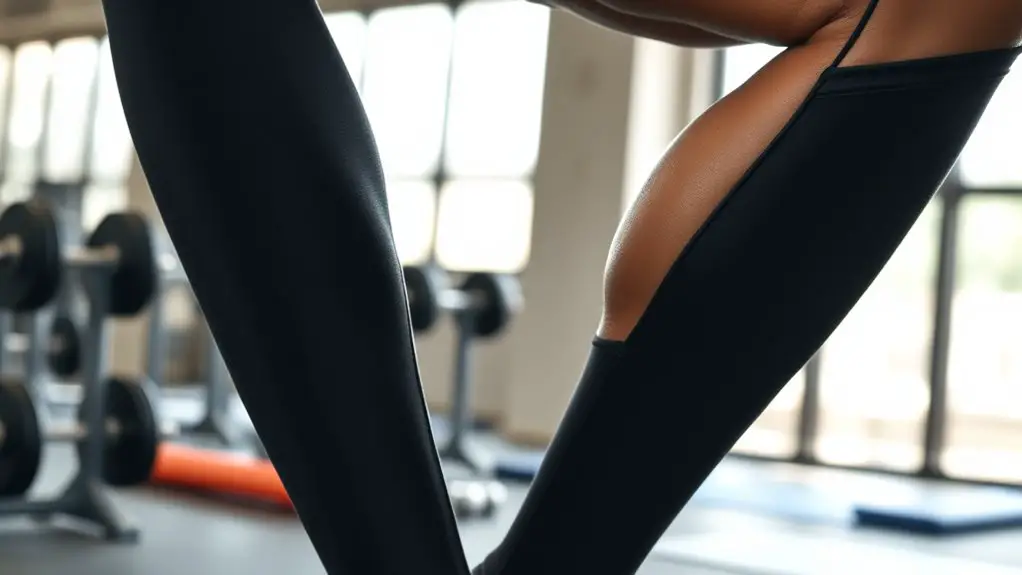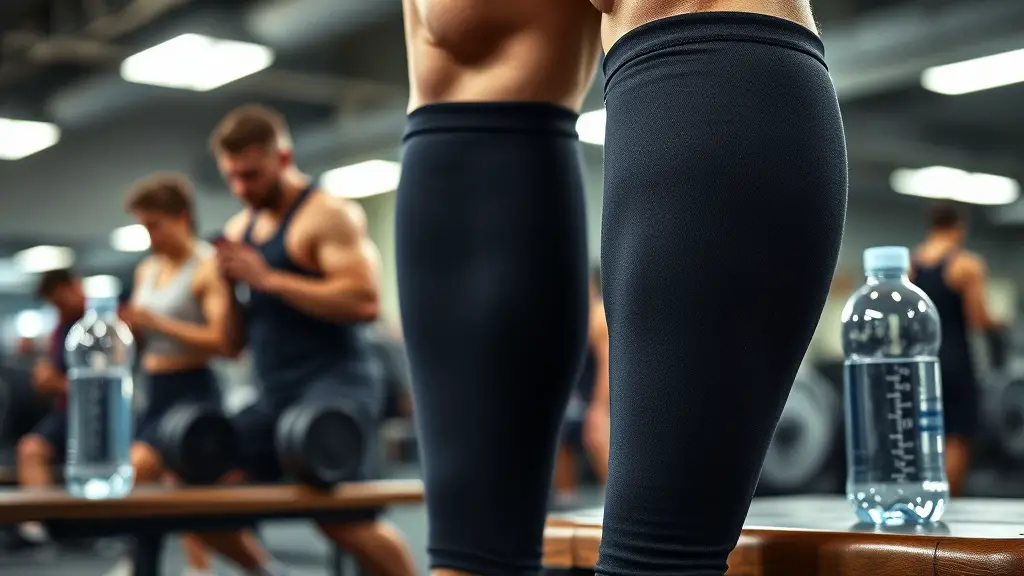The Role of Compression Therapy in Strength Training Recovery

Compression therapy plays a crucial role in strength training recovery. It enhances blood circulation, which improves oxygen and nutrient delivery to your muscles. This process reduces muscle soreness and helps flush out metabolic waste, leading to quicker recovery times. Additionally, compression gear stabilizes muscles and joints, minimizing injury risk during workouts. By integrating compression therapy into your routine, you can optimize your recovery strategy and performance. Discover more about how it can benefit you.
Understanding Compression Therapy

Compression therapy, which involves the application of controlled pressure to the limbs, can greatly enhance recovery in strength training. Historically, compression technology has roots in medical practices, used as far back as ancient times to manage swelling and improve circulation. Today, athletes and fitness enthusiasts utilize advanced compression garments and devices to optimize recovery.
You might not realize that the effectiveness of compression therapy lies in its ability to reduce muscle soreness and enhance blood flow, which can speed up recovery post-exercise. Studies indicate that wearing compression gear during workouts may also reduce lactic acid build-up, allowing you to train harder and recover faster.
Moreover, the consistent application of pressure helps prevent injuries by stabilizing muscles and joints. By integrating compression therapy into your routine, you’re leveraging a time-tested method that combines historical usage with modern innovation, ultimately supporting your strength training goals.
The Science Behind Compression
While many athletes swear by the benefits of compression therapy, the underlying science reveals a complex interplay of physiological responses that contribute to its efficacy in recovery. Compression science indicates that applying pressure to muscles can enhance venous return, facilitating improved blood flow. This increased circulation helps to remove metabolic waste products, such as lactic acid, that accumulate during intense exercise.
Moreover, the physiological effects of compression may include a reduction in muscle oscillation during activity, which can decrease microtrauma and inflammation post-exercise. Studies suggest that the application of graduated compression can lead to a more efficient delivery of oxygen and nutrients to the tissues, promoting faster recovery. Ultimately, understanding these mechanisms is vital for athletes looking to optimize their recovery strategies and enhance performance through evidence-based practices.
Benefits of Compression Therapy for Muscle Recovery

Compression therapy can considerably enhance blood circulation, which aids in delivering essential nutrients to your muscles post-exercise. This improved circulation may also contribute to a reduction in muscle soreness, allowing you to recover more efficiently. Understanding these benefits can help you optimize your recovery strategy and performance.
Enhanced Blood Circulation
When considering effective recovery strategies, enhanced blood circulation plays an essential role in muscle recovery, particularly for those engaged in intense strength training. Compression therapy employs various circulation techniques to promote blood flow, facilitating the delivery of oxygen and nutrients to fatigued muscles. This improved circulation can help remove metabolic waste products, which may otherwise impede recovery. Studies have shown that utilizing compression garments can greatly increase venous return, leading to better overall blood flow during and after workouts. By optimizing blood circulation, you can enhance the efficiency of your recovery process, allowing you to train harder and more frequently. Incorporating compression therapy into your routine could be a strategic move for maximizing your strength training outcomes.
Reduced Muscle Soreness
Enhanced blood circulation not only aids in nutrient delivery but also plays a notable role in reducing muscle soreness following intense strength training sessions. Compression therapy enhances this process, promoting muscle recovery and soreness reduction effectively. By applying consistent pressure, it helps to minimize the inflammatory response and enhances your body’s natural healing processes.
Here are three key benefits of compression therapy for reducing muscle soreness:
- Increased Oxygen Delivery: Improved blood flow guarantees muscles receive the oxygen needed for efficient recovery.
- Lactic Acid Removal: Compression aids in flushing out metabolic waste, reducing post-exercise stiffness and soreness.
- Enhanced Recovery Time: With effective soreness reduction, you can return to training sooner and maintain your performance levels.
Incorporating compression therapy into your routine can notably enhance your muscle recovery.
How Compression Therapy Enhances Blood Circulation
Compression therapy markedly improves blood circulation, which is essential for ideal recovery. It enhances oxygen delivery to muscles and increases nutrient exchange, facilitating faster healing and performance gains. Understanding these mechanisms can help you maximize the benefits of your training regimen.
Improved Oxygen Delivery
As athletes push their limits during strength training, the need for efficient oxygen delivery to muscles becomes paramount for ideal recovery. Compression therapy enhances blood circulation, thereby improving oxygen transport, which is essential for muscle endurance. By applying targeted pressure, compression garments can help to:
- Increase Blood Flow: Enhanced circulation means more oxygen-rich blood reaches fatigued muscles.
- Reduce Muscle Fatigue: Improved oxygen delivery helps in faster recovery, reducing the onset of fatigue during subsequent workouts.
- Support Lactic Acid Clearance: Efficient oxygen transport aids in the removal of metabolic waste, further promoting recovery.
Utilizing compression therapy can be a game-changer in optimizing your recovery process, ensuring your muscles are ready for the next training session.
Enhanced Nutrient Exchange
When blood circulation improves, so does the exchange of essential nutrients necessary for muscle recovery and growth. Compression therapy enhances blood flow, which directly influences nutrient absorption at the cellular level. With increased circulation, your muscles receive important nutrients like amino acids and glucose more efficiently. This heightened flow not only promotes faster recovery but also boosts metabolic efficiency, allowing your body to utilize these nutrients more effectively for repair and growth. Studies indicate that improved nutrient exchange can lead to enhanced muscle protein synthesis, significant for strength training success. By incorporating compression therapy into your recovery routine, you can optimize nutrient delivery, ultimately supporting your training goals and minimizing recovery time.
Reducing Muscle Soreness With Compression

While muscle soreness after intense strength training is common, incorporating compression therapy may greatly alleviate discomfort. Research indicates that compression garments can enhance muscle recovery and promote soreness reduction, allowing you to bounce back faster. Here are three key benefits of using compression for muscle soreness:
- Improved Circulation: Compression increases blood flow, delivering essential nutrients to fatigued muscles and accelerating the recovery process.
- Reduced Inflammation: By applying consistent pressure, compression therapy can help decrease muscle swelling and inflammation, which are common contributors to soreness.
- Enhanced Comfort: Wearing compression gear often provides a comforting sensation, which can psychologically aid in managing pain levels during recovery.
The Role of Compression in Injury Prevention
Compression therapy not only aids in recovery from muscle soreness but also plays a significant role in injury prevention. By applying consistent pressure to your muscles, compression garments enhance blood flow, which can lead to improved oxygen delivery and nutrient supply. This heightened circulation is essential for maintaining muscle integrity and reducing the risk of strains or sprains during intense training sessions.
Incorporating compression into your workout routine serves as one of the effective injury reduction strategies. When you wear compression gear, you can experience increased proprioception, which helps you maintain better body awareness and control. This heightened awareness can be vital in avoiding awkward movements that often lead to injury.
Using compression as a proactive recovery technique not only prepares your muscles for the next workout but also minimizes the chances of sustaining injuries, allowing you to train harder and more consistently over time.
Different Types of Compression Gear

Choosing the right compression gear can greatly enhance your recovery and overall performance during strength training. Various types of compression gear serve specific purposes, and understanding their benefits can help you make an informed choice.
Selecting the appropriate compression gear can significantly boost your recovery and performance in strength training.
- Compression Sleeves: These provide targeted support to muscles and joints, reducing muscle soreness and enhancing blood flow through graduated compression.
- Compression Socks: Ideal for lower leg recovery, compression socks improve circulation and reduce swelling post-workout, promoting faster recovery.
- Compression Shorts and Leggings: Offering full body compression, these items stabilize muscles and reduce fatigue, making them perfect for intense training sessions.
Incorporating compression tops or wraps can further enhance recovery by providing additional support. Each type of gear plays a crucial role in optimizing your recovery process, ensuring you’re ready to tackle your next workout with confidence.
Incorporating Compression Therapy Into Your Routine
Integrating compression therapy into your routine can markedly enhance recovery and performance, especially after intense strength training sessions. To maximize benefits, consider the recovery timing of your compression routine. Applying compression gear post-workout can help reduce muscle soreness and inflammation, speeding up recovery.
Here’s a simple table to help you structure your compression routine effectively:
| Time Frame | Activity | Compression Gear |
|---|---|---|
| Immediately Post-Workout | Cool down and stretch | Compression sleeves |
| 1-2 Hours Post-Workout | Rest and hydrate | Compression socks |
| 24 Hours Post-Workout | Light activity | Full-body compression garments |
Real-Life Success Stories and Testimonials

Many athletes and fitness enthusiasts have reported significant improvements in their recovery journeys after incorporating compression therapy into their routines. These personal experiences reflect the tangible benefits of compression garments, supported by numerous athlete testimonials.
Here are three remarkable examples:
- Increased Recovery Speed: A competitive runner shared that using compression socks reduced muscle soreness post-race, allowing for faster recovery times and improved performance in subsequent training sessions.
- Enhanced Circulation: A weightlifter noted that wearing compression sleeves during workouts improved blood flow, leading to reduced fatigue and enhanced endurance during intensive lifts.
- Less Swelling: A triathlete experienced decreased swelling in the legs after long training sessions, crediting compression therapy for maintaining peak performance levels.
These testimonials underscore the effectiveness of compression therapy, illustrating how it can be a game-changer in your strength training recovery strategy.
Frequently Asked Questions
How Long Should I Wear Compression Gear After a Workout?
You should wear compression gear for about 30 minutes to two hours after a workout to maximize recovery benefits. The compression duration can vary based on your activity intensity and personal comfort. Studies suggest that wearing it during this time can help reduce muscle soreness and enhance blood flow, aiding recovery. It’s important to listen to your body and adjust the duration accordingly, ensuring you get the most out of your recovery process.
Can Compression Therapy Help With Chronic Muscle Pain?
Compression therapy can indeed help with chronic muscle pain. By applying consistent pressure, it may improve blood circulation, reduce inflammation, and promote muscle recovery. Research suggests that enhanced blood flow can alleviate discomfort and accelerate the healing process for those suffering from chronic pain. While individual results can vary, incorporating compression garments into your routine might provide relief and support overall muscle health, making it a worthwhile consideration for managing chronic issues.
Is Compression Therapy Safe for Everyone?
Compression therapy isn’t universally safe for everyone. Medical considerations, such as circulatory issues or skin conditions, must be evaluated before use. While many people find it beneficial, individual preferences and responses can vary. Some might experience discomfort or adverse reactions, so it’s essential to consult a healthcare professional. They can help determine if compression therapy is appropriate for you based on your health status and specific needs. Always prioritize your safety and comfort.
Can I Use Compression Gear for Running and Strength Training?
Ever wondered if you can double dip with your gear? Yes, you can absolutely use compression gear for both running and strength training. Studies show that it can enhance blood flow, which may lead to improved running benefits and strength enhancements. By wearing compression garments, you might experience reduced muscle soreness and faster recovery times, making your workouts more effective. Just be sure to choose the right fit for maximum benefits!
How Do I Choose the Right Compression Level?
When choosing the right compression level, you’ll want to take into account your specific needs and activities. Generally, lower compression levels (15-20 mmHg) are suitable for everyday wear or light exercise, while higher levels (20-30 mmHg) are better for intense workouts or recovery. Evaluate the gear’s intended purpose and how your body responds during activities. It’s essential to select gear that provides adequate support without restricting blood flow or causing discomfort.





